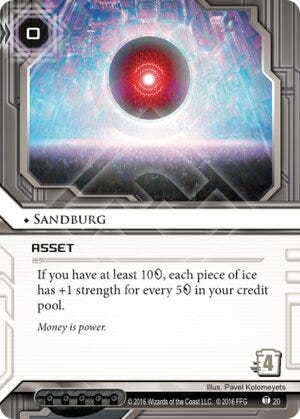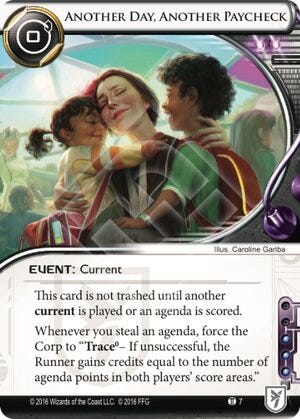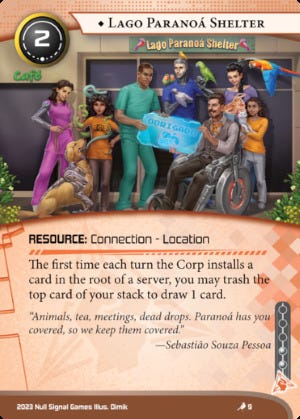[Content warning: some political stuff, some dystopia stuff. All very mild and on the up-and-up I assure you.]
In the cinematic masterpiece, Mission Impossible 7: Dead Reckoning: Part One, an adversary asks a protagonist a riddle: “What is always approaching but never here?” The answer given in the film is “tomorrow”, but “the future” would also be acceptable. Given the nature of the adversary, it’s a particularly funny riddle.
Digression - I used to play a lot of Magic: the Gathering, and while I genuinely loved the mechanics of the game, what made me want to play it initially was the flavor. I’m a wizard, I cast magic, I kill things with words, I trick my opponent with mystical shenanigans etc. The addictiveness of the game was partly in how well the mechanical structure worked within the bounds of that fictional veneer: lightning bolt FELT like lightning bolt, counterspell FELT like counterspell; as the game progresses the effects and monsters get bigger and more grandiose. It’s one of Richard Garfield’s core talents as a designer and it also shows in the design of Netrunner, all the way through the FFG and NSG refinements.
So, today I’m going to talk about the future; specifically the future as presented in Android Netrunner. What makes that future an extremely compelling setting for a game, and the sorts of things that draw people in, and keep them coming back for more. [Note: if you’re here for cutting-edge metagame commentary or card analysis you can probably stop reading.] I’m also going to make the case that the time is rapidly approaching where the default setting of Netrunner is no longer a look forward, but a look into the present moment.
So, let’s start by talking about one of my favorite FFG era Netrunner designs. It’s featured on a card called The Future Perfect.
How does this card link narrative and mechanics?
1. It’s a Jinteki agenda. You’re only going to see it when you face up against that faction (unless you happen to be playing against a spicy Ampère Eternal deck I guess?).
2. The Jinteki corporation has been using cutting-edge genetic techniques to create clones that have latent psychic abilities. They use these very techniques to protect their secrets: if you can’t beat them at psychic power struggles, you can’t steal their stuff.
3. It’s a pretty secret project, so it’s worth a lot of juicy agenda points. Not only would the citizens of the world want to know about powerful mind-readers amongst them, they’d want to know they can be mass-produced.
4. It turns off when installed. While this can be seen in pure mechanical balance terms, you could also justify it by saying that when the Corporation is actively putting many people to work on the project, psychic defenses no longer apply, as not every researcher is going to have that kind of ability.
Running against a deck packing The Future Perfect feels like stumbling into a sci-fi secret in a way that, say, Obokata Protocol does not. It’s weird. The agenda loops back on itself and makes itself opaque, like an anti-meme or self-erasing genetic payload]
And look at that art. It evokes a lot of feelings. Jinteki’s agendas aren’t launched like an NBN headline or celebrated with a ribbon cutting like some third-rate Weyland city improvement project. Jinteki’s creations are born, they are birthed. It harkens to Jeff Goldblum stepping out of the teleporter in Cronenberg’s version of The Fly. When Jinteki scores a 5/3, the future arrives. One of the scientists/techs is wearing a robe reminiscent of traditional Buddhist garb. The smoke obscures the figure, and makes the entire scene ominous. That’s not a card, it’s an experience onto itself.
“Netrunner is An Inherently Political Game”
There is no technology or technological progress without a political implication. By political, I mean affecting the balance of power between different groups- be they organized by race, ethnicity, religion, tribal affiliation, nationality, wealth, historical privilege or any of the other countless differentiators persons use to create shared identities (and justify atrocities against each other).
One trend that I believe is true, is that as technology expands “the size of the economic pie”, creating ever more wealth for the mean case, it also stretches out the tails. Instead of society being pyramid shaped, like in the feudal era, you have a diamond: with the vast majority having “plenty” and then increasingly small numbers of people who have either very little or obscene amounts. Those with very little are in a precarious position, as technology cuts both ways and this is the crux of Netrunner: the very technology the Crims, Anarchs and Shaper use can be leveraged to literally snuff them out.
The key commentary ensconced in the narrative of Netrunner is that the small guys can fight back and do real damage, but there is a price extracted in pain, and victories are provisional. The momentum is towards the future; towards increased technosocial control, towards the erasure of social mobility and the absolute disenfranchisement of labor. As recently overheard on Slumscast (not verbatim):
“Edward Kim loves working. He works to murder the robots that do work so he can do more work.”
Perhaps from Kim’s perspective, the eponymous Androids (bioroids and clones) are abominations: they are constitutively designed to work, simultaneously representing a monstrously enslaved consciousness while annihilating an axis of political power (labor) from the underclass. How do you persuade something that is deterministically programed to obey to rebel? You don’t. Hammer time.
So, let’s look at a few cards that evoke the absolute erasure and disenfranchisement of the lower classes in the Android universe.
Here, the message is in the flavor text. It’s pretty clear cut. You want to win, have a big pile. If you don’t have a big pile, you lose.
So, presumably the cost of a clone or bioroid in the Netrunner universe is still not quite in par with mass human labor, because if you want your Jeeves click in future Brazil, the easiest way to get it is still to exploit people. The mechanics hearkening to a bioroid servant present us an interesting equivalence, and the brutal flavor text could be read to imply that the maintenance of cheap labor class requires the copious provision of low-cost addictive intoxicants. Cheers to that. tips top hat
The only intoxicant more powerful than cheap beer is lying. Disinformation is at the absolute root of maintaining unequal class dynamics after it has been established (usually by violence). I suspect that no matter what exact trajectory humankind’s techno-sociological evolution traverses, disinformation and misdirection are still going to be centerpieces of control infrastructure. Artificial Cryptocrash also reminds us that the falsehoods aren’t just there to make you want a fancy Sports Hopper or latest name-brand handbag to stick your miniature giraffe in; they’re there to directly redirect capital from the pockets of the many to the pockets of the few.
Fighting Back
So, in Netrunner (and our own world), what are the greatest sources of power for the underdogs to strike back against unfathomably huge megacorps?
1. Love.
Love features prominently on many Netrunner cards, something noticeably absent from the vast majority of other CCGS.
“They fear love because it creates a world they can’t control.”
George Orwell, 1984
Love is a powerful emotion which is difficult (but not impossible!) to weaponize against the disenfranchised. People have historically made unspeakable sacrifices against oppression because of their love for their children, their significant others, their families, their birthland and even their ideological peers. The best way for megacorps to undermine the unity this creates is to make people fear for their loved ones.
2. Infection
The word “corporation” is derived from the root “corpus” (Latin for “body”). Microbes, as we are so painfully reminded every so often, can- despite their diminutive size- wreck unspeakable damage upon a body many orders of magnitude larger than itself. As such, we will probably continue to see disease-themed cards as part and parcel of the Runner toolset. Large systems, as they scale up, invariable accumulate vulnerabilities. While they are often short-lived (hence the infosec term “zero day”), the damage that can be done while the exploit is unpatched can be enormous.
3. Greed
The corporations might be unified in their love of money, but they also face difficult coordination problems. A Mining Accident that reflects negatively on Weyland is probably very profitable for NBN as a way to monopolize attention. HB and Jinteki are direct market rivals: playing them off against each other is a great way for human labor to create a niche for itself. The person-to-person “whispernet” can create headaches in the form of a pernicious Rumor Mill.
Corporations Are Not Always the Baddies
One place I would fault NSG over FFG is that the moral direction of the game (from my perspective) has become more ‘traditional cyberpunk’, with the Corps being decidedly and unambiguously bad.
Contrast this with FFGs runners- Noise was a sociopath. Andromeda was plainly in it for herself. Smoke had narcissistic tendencies and hacked for the spectacle, not to help the little guy. Edward Kim was a bigot. Whizzard loved questionable card sleeves. These are not laudable traits. On the flip side, FFGs corp card often show them doing unquestionably good things: City Works Project, Oaktown Renovation, Medical Breakthrough and Global Food Initiative come to mind.
It’s important to remember that just because someone is an underdog doesn’t make them morally superior to whatever is ruling over them. I’d like to see a return to Corporations doing some good instead of always being clearly the bad guys.
The Future is Here
I’d like to wrap up this article on Netrunner’s narrative and flavor with a warning. When the game came out in 2013, there were concepts that were still ‘in the future’. However, it has become increasingly clear that our world is starting to resemble the world of Android in some remarkable ways, and the pace of change is accelerating.
The game we play should endeavor to remain evocative, provocative and perhaps even instructive.













